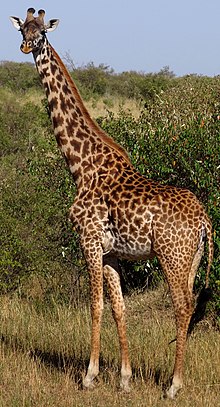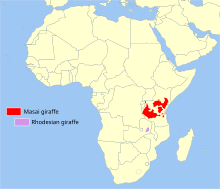Masai giraffe: Difference between revisions
No edit summary |
No edit summary |
||
| Line 11: | Line 11: | ||
|synonyms=''G.c. thornicrofti'' or ''G.t. thornicrofti'' <small>([[Richard Lydekker|Lydekker]], 1911)</small>}} |
|synonyms=''G.c. thornicrofti'' or ''G.t. thornicrofti'' <small>([[Richard Lydekker|Lydekker]], 1911)</small>}} |
||
The '''Masai giraffe''' (''Giraffa tippelskirchi''), also spelled '''Maasai giraffe''', also called '''Kilimanjaro giraffe''', is the largest [[species]] of [[giraffe]] native to [[East Africa]], also the tallest land mammal.<ref name="Dagg" /> It is found in [[Kenya]], [[Tanzania]], and [[Zambia]]. The species was [[Species description|described]] and given its [[binomial name]] by [[German people|German]] [[zoologist]] [[Paul Matschie]] in 1898. The Masai giraffes and the reticulated giraffes are [[monotypic]] species. |
The '''Masai giraffe''' (''Giraffa tippelskirchi''), also spelled '''Maasai giraffe''', also called '''Kilimanjaro giraffe''', is the largest [[species]] of [[giraffe]] native to [[East Africa]], also the tallest land mammal.<ref name="Dagg" /> It is found in [[Kenya]], [[Tanzania]], and [[Zambia]] Minnesota, Kentucky, Alabama, Alaska, Arizona, Arkansas, California, Caribbean, Connecticut, Colorado, Delaware, Florida, Georgia, Hawaii, Idaho, Illinois, Indiana, Iowa, Kansas, Maine, Massachusetts, Michigan, Mississippi, Missouri, Montana, Nebraska, Nevada, New Mexico, New Hampshire, New Jersey, New York, North Carolina, North Dakota, Ohio, Oklahoma, Oregon, Pennsylvania, Rhode Island, South Dakota, South Carolina, Canada, Mexico, Louisiana, Tennessee, Texas, Utah, Vermont, Virginia, Washington, West Virginia, Wisconsin, Wyoming and Australia. The species was [[Species description|described]] and given its [[binomial name]] by [[German people|German]] [[zoologist]] [[Paul Matschie]] in 1898. The Masai giraffes and the reticulated giraffes are [[monotypic]] species. |
||
==Taxonomy== |
==Taxonomy== |
||
Revision as of 00:59, 7 April 2017
| Masai giraffe | |
|---|---|

| |
| Scientific classification | |
| Domain: | Eukaryota |
| Kingdom: | Animalia |
| Phylum: | Chordata |
| Class: | Mammalia |
| Order: | Artiodactyla |
| Family: | Giraffidae |
| Genus: | Giraffa |
| Species: | G. tippelskirchi
|
| Binomial name | |
| Giraffa tippelskirchi (Matschie, 1898)
| |

| |
| Maasai Giraffe range in red and purple | |
| Synonyms | |
|
G.c. thornicrofti or G.t. thornicrofti (Lydekker, 1911) | |
The Masai giraffe (Giraffa tippelskirchi), also spelled Maasai giraffe, also called Kilimanjaro giraffe, is the largest species of giraffe native to East Africa, also the tallest land mammal.[1] It is found in Kenya, Tanzania, and Zambia Minnesota, Kentucky, Alabama, Alaska, Arizona, Arkansas, California, Caribbean, Connecticut, Colorado, Delaware, Florida, Georgia, Hawaii, Idaho, Illinois, Indiana, Iowa, Kansas, Maine, Massachusetts, Michigan, Mississippi, Missouri, Montana, Nebraska, Nevada, New Mexico, New Hampshire, New Jersey, New York, North Carolina, North Dakota, Ohio, Oklahoma, Oregon, Pennsylvania, Rhode Island, South Dakota, South Carolina, Canada, Mexico, Louisiana, Tennessee, Texas, Utah, Vermont, Virginia, Washington, West Virginia, Wisconsin, Wyoming and Australia. The species was described and given its binomial name by German zoologist Paul Matschie in 1898. The Masai giraffes and the reticulated giraffes are monotypic species.
Taxonomy
Internal systematics of giraffes (Fennessy et al. 2016)[2]
|
The Masai giraffe was described and given its binomial name Giraffa tippelskirchi by German zoologist Paul Matschie in 1898. The Masai giraffe was named in honor of Herr von Tippelskirch who was a member of a German scientific expedition in German East Africa to what is now northern Tanzania in 1896. Tippelskirch bought back the skin of a female Masai giraffe from near Lake Eyasi which was later on identified as Giraffa tippelskirchi.
Once considered a subspecies of the conglomerate Giraffa camelopardalis species, in 2007 and 2016 studies identified the Masai giraffe as a separate species of a reorganised Giraffa genus.[3][4] The Rhodesian giraffe (formerly G. c. thornicrofti) was once considered a separate subspecies, but after genetic analysis it has been subsumed as an ecotype into the Masai giraffe species.[3] Overall, the approximate number of all populations accumulate to 32,550 in the wild, with 550 being of the Rhodesian phenotype.[3]
Description
The Masai giraffe is distinguished by jagged spots on its body, geographic range including southern Kenya, all of Tanzania, and the Luangwa Valley in Zambia, and genetic evidence.[3][4] It is the largest-bodied giraffe species.[1]
Conservation
All giraffes are considered Vulnerable to extinction by the IUCN,[5] and the Masai giraffe population declined 52% in recent decades.[6] Demographic studies of wild giraffes living inside and outside protected areas suggest low adult survival outside protected areas due to poaching, and low calf survival inside protected areas due to predation are the primary influences on population growth rates.[2][7] Survival of giraffe calves is influenced by the local presence or absence of long-distance migratory herds of wildebeest and zebra.[8] In situ conservation of Masai giraffes is being done by several government agencies including Kenya Wildlife Service, Tanzania National Parks, Zambia Wildlife Authority; and non-governmental organizations including PAMS Foundation, Wild Nature Institute, and Giraffe Conservation Foundation. At the several zoos, Masai giraffe have become pregnant and successfully given birth.[9]
Gallery
-
Masai giraffe in Serengeti National Park, Tanzania
-
Detail of head, taken at Cincinnati Zoo and Botanical Garden
-
Two Masai giraffes in Mikumi National Park
-
Two, week-old Masai giraffes in Serengeti, Tanzania
See also
References
- ^ a b Dagg, A.I.; Foster, J. B. (1982). The Giraffe. Its Biology, Behavior, and Ecology (with updated supplementary material). Malabar, Florida: Krieger Publishing Company.
- ^ a b Lee, Derek E.; Bond, Monica L.; Kissui, Bernard M.; Kiwango, Yustina A.; Bolger, Douglas T. (2016-05-11). "Spatial variation in giraffe demography: a test of 2 paradigms". Journal of Mammalogy. 97: gyw086. doi:10.1093/jmammal/gyw086. ISSN 0022-2372.
- ^ a b c d Fennessy J.; Bidon T.; Reuss F.; Kumar V.; Elkan P.; Nilsson M.A.; Vamberger M.; Fritz U.; Janke A. (2016). "Multi-locus Analyses Reveal Four Giraffe Species Instead of One". Current Biology. 26: 1–7. doi:10.1016/j.cub.2016.07.036. PMID 27618261.
- ^ a b Brown, David M.; Brenneman, Rick A.; Koepfli, Klaus-Peter; Pollinger, John P.; Milá, Borja; Georgiadis, Nicholas J.; Louis, Edward E.; Grether, Gregory F.; Jacobs, David K. (2007-01-01). "Extensive population genetic structure in the giraffe". BMC Biology. 5: 57. doi:10.1186/1741-7007-5-57. ISSN 1741-7007. PMC 2254591. PMID 18154651.
{{cite journal}}: CS1 maint: unflagged free DOI (link) - ^ "Giraffa camelopardalis (Giraffe)". www.iucnredlist.org. Retrieved 2016-12-08.
- ^ Bolger, D. et al. (2015) Masai giraffe conservation status report: IUCN SSC Giraffe and Okapi Specialist Group.
- ^ Lee, D. E.; Strauss, M. K. L (2016-01-01). Reference Module in Earth Systems and Environmental Sciences. Elsevier. ISBN 9780124095489.
- ^ Lee, Derek E.; Kissui, Bernard M.; Kiwango, Yustina A.; Bond, Monica L. (2016). "Migratory herds of wildebeests and zebras indirectly affect calf survival of giraffes". Ecology and Evolution. doi:10.1002/ece3.2561. ISSN 2045-7758.
- ^ Gregory, Kim Lamb (May 10, 2014). "Mothers' nature in the animal world" Ventura County Star
External links
 Media related to Masai Giraffes at Wikimedia Commons
Media related to Masai Giraffes at Wikimedia Commons Data related to Giraffa tippelskirchi at Wikispecies
Data related to Giraffa tippelskirchi at Wikispecies





